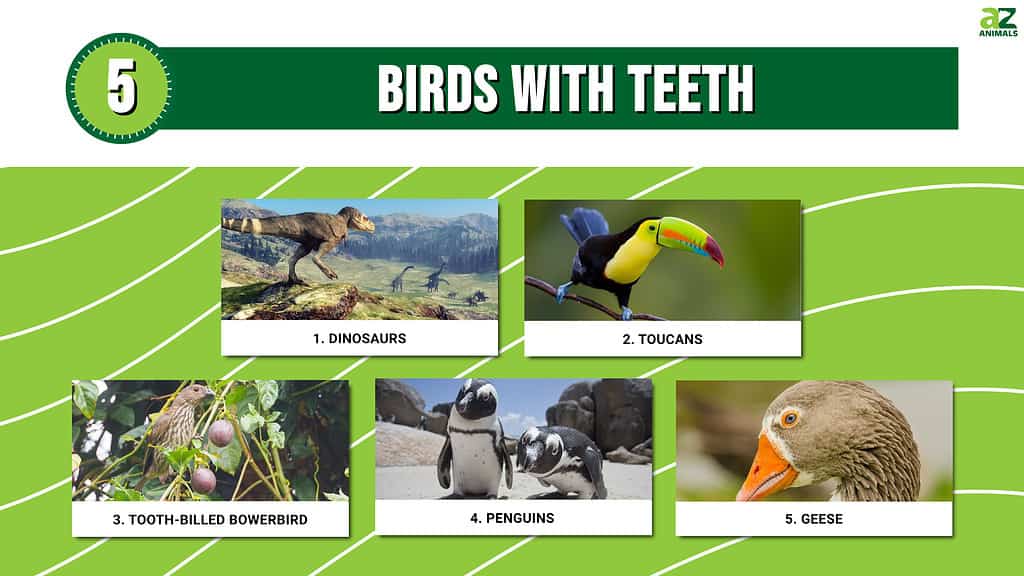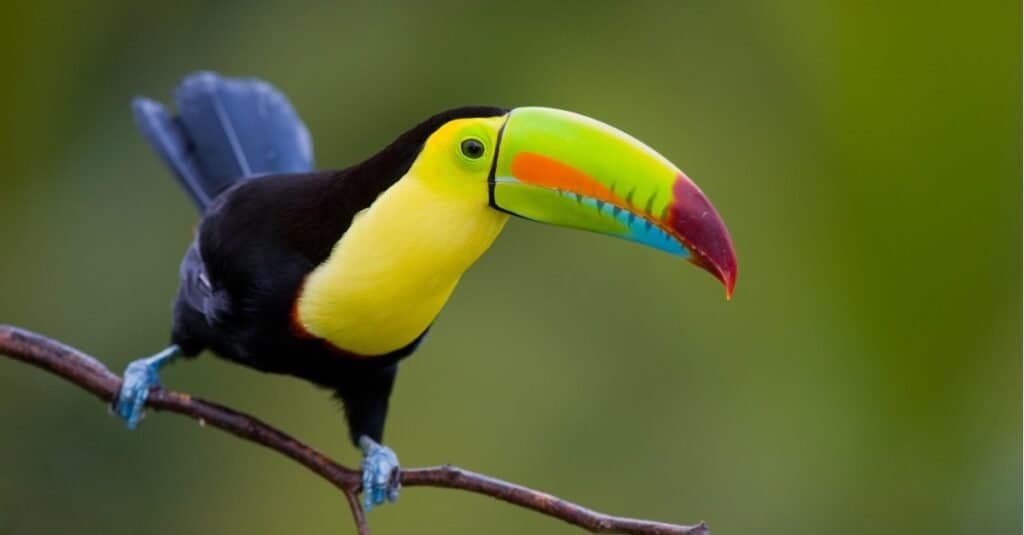Animals evolved different types of teeth depending on what kind of food they eat. Generally, herbivores possess flat teeth suitable for grinding vegetable matter. Meanwhile, carnivores rely on their sharp teeth to pierce and tear off animal flesh. Some animals, such as sharks, constantly regrow their teeth, while others, like narwhals, have teeth shaped like horns. Most mammals and reptiles have teeth, and even some amphibians as well. However, there is one group of animals that completely lack teeth: birds. Modern birds do not possess teeth, unlike their ancient avian ancestors, the dinosaurs, and other prehistoric birds. When feeding, most birds either swallow their prey whole or use their sharp beaks to chop their food into pieces. Still, it begs the question, are there any birds with teeth?

Given the abundance of photos online showing birds with “teeth,” this subject is worth exploring in more depth. Today, we’ll discuss 5 different birds with teeth, or at least with features that look like teeth. We’ll explain where these birds live, what they look like, and what they eat. In addition, we’ll examine their teeth, and discuss how they differ from actual teeth. That way, the next time you hear the claim that birds have teeth, you’ll know what to say to put the conversation to rest. Without further ado, let’s chew into the topic of birds with teeth.
#5: Geese

Geese possess teeth-like structures called tomia which help them to rip out and eat grasses.
©Joos/Shutterstock.com
Along with swans and ducks, the goose belongs to the waterfowl family Anatidae. In total, there exist more than 20 individual species. While some birds bear the name goose, such as the African pygmy goose, these birds are technically ducks or swans. Most geese fall into either the genus Anser, or white or gray geese, or Branta, or black geese. You can find geese on every continent except Antarctica, typically in wetland habitats. That said, they also spend a significant amount of time in fields, meadows, and open urban areas. Most geese possess long, slender necks, flat bills that taper near the tip, and webbed feet. Geese primarily eat grasses, roots, stems, seeds, and berries, but will also eat insects. Behind the chicken, geese rank as one of the most common domesticated birds in the world. Today, many domesticated breeds exist outside of the true, wild geese species.
While many people consider geese to be birds with teeth, this is a widespread misconception. This belief comes from the tiny, teeth-like structures that line a goose’s beak and tongue. These structures, called tomia, are made from tomium, a hard type of cartilage. Depending on the species, tomia can appear long or short, abundant or sparse. Geese evolved tomia to help them feed on grasses. While feeding, they rely on their “teeth” to help them rip and tear out grasses. Although tomia technically aren’t teeth, they are still very sharp. If threatened or when defending its territory, a goose can act very aggressively, and some will attack humans. Therefore, it’s best to give them a wide berth if you don’t want to get bit.
#4: Penguins

Penguin mouths are full of hooked structures made of keratin called papillae, which help them to grab onto fish.
©Mike Korostelev/Shutterstock.com
Another group of birds with teeth that aren’t teeth, penguins belong to the family Spheniscidae. Overall, there exist 18 different species of penguin, most of which live in Antarctica or its surrounding islands. In addition, they also live near the southern coasts of South America, Africa, and Australia. While some penguins, such as the emperor penguin, migrate great distances, others live in the same habitats year-round. Penguins sport tapered upright bodies, long flippers, webbed feet, and large, pointed bills. They range in size from 12 inches to 4.3 feet tall and between 3.3 to 41 pounds. Although they can’t fly, penguins can swim exceptionally well. At their fastest, they can swim nearly 5.6 miles per hour and hold their breath for up to 20 minutes. Their speed and abilities in water aid them in hunting for food including fish, krill, and squid.
Penguins also make it onto our list of birds with teeth, although like the others, they also lack actual teeth. The bill of a penguin is made of keratin and normally ends in a hook, which helps them to grip objects. Inside of a penguin’s bill is a wild array of spiky, teeth-looking structures called papillae. Also made from keratin, papillae line a penguin’s tongue, upper palate, and lower palate. They curve toward the back of a penguin’s mouth, which helps them to grab onto slippery fish. In a sense, penguins possess built-in fish hooks inside their mouths that keep their meals from escaping.
#3: Tooth-Billed Bowerbird

The tooth-billed bowerbird has serrations along its bill, which helps it to cut through the stems of leaves.
©Jukka Jantunen/Shutterstock.com
Also known as the tooth-billed catbird, the tooth-billed bowerbird is a member of the bowerbird family Ptilonorhynchidae. It’s endemic to Australia and prefers to live in forests at high elevations. Most specimens measure around 11 inches long. Their plumage appears green-brown on their backs and heads, and white with brown streaks on their chests and underparts. They eat a diet of mostly fruits and leaves from trees, although they will also eat insects and seeds. Like all bowerbirds, the male tooth-billed bowerbird builds a bower or structure to attract a potential mate. It gets its name from its unique bill, which contains serrated edges that look like teeth. This adaptation leads many casual observers to mischaracterize them as birds with teeth. In reality, their bill is merely notched, which helps them to cut through the stems of leaves and succulents.
#2: Toucans

Toucans have bills that contain forward-facing serrations that look like teeth.
©iStock.com/edurivero
Toucans belong to the family Ramphastidae, which also includes barbets and aracaris. Overall, there exist over 40 species of toucan, all of which live in Mexico, Central America, and South America. They do not migrate and generally live in lowland tropical forests with large old-growth trees. On average, they measure between 11 to 25 inches long and weigh between 0.25 to 1.5 pounds. In addition, they sport short bodies and wings, rounded tails, and large, colorful bills. Their diet consists mostly of fruit, although they also eat insects, small birds, and reptiles. A toucan’s bill is made from keratin and contains numerous forward-facing serrations. These serrations are why many consider toucans as birds with teeth. Some scientists believe that their “toothy” bills may help them to scare off other birds so they can raid their nests. Male toucans will also use their bills when wrestling to establish dominance.
#1: Dinosaurs

Modern, toothless birds evolved from tooth dinosaurs and contemporary bird-like replies.
©Orla/Shutterstock.com
Modern birds likely evolved from Jurassic-era dinosaurs known as theropods. Examples of theropods include the Tyrannosaurus rex and velociraptor. Unlike modern birds, these ancient “birds” contained mouths full of teeth. One of the earliest known ancestors of modern birds is Archaeopteryx. This bird-like dinosaur’s name translates in ancient Greek to “ancient wing.” It lived almost 150 million years ago and ranged throughout what is now modern central Europe. They measured around 20 inches long and had a long, bony tail, similar to other dinosaurs of the time. In addition, they possess small, sharp teeth inside their bill. Along with several even earlier species, archaeopteryx likely helped pave the way for modern, toothless birds.
Summary Of 5 Birds With Teeth
| Rank | Bird |
|---|---|
| 1 | Dinosaurs |
| 2 | Toucans |
| 3 | Tooth-Billed Bowerbird |
| 4 | Penguins |
| 5 | Geese |
The photo featured at the top of this post is © iStock.com/leekris
Thank you for reading! Have some feedback for us? Contact the AZ Animals editorial team.






